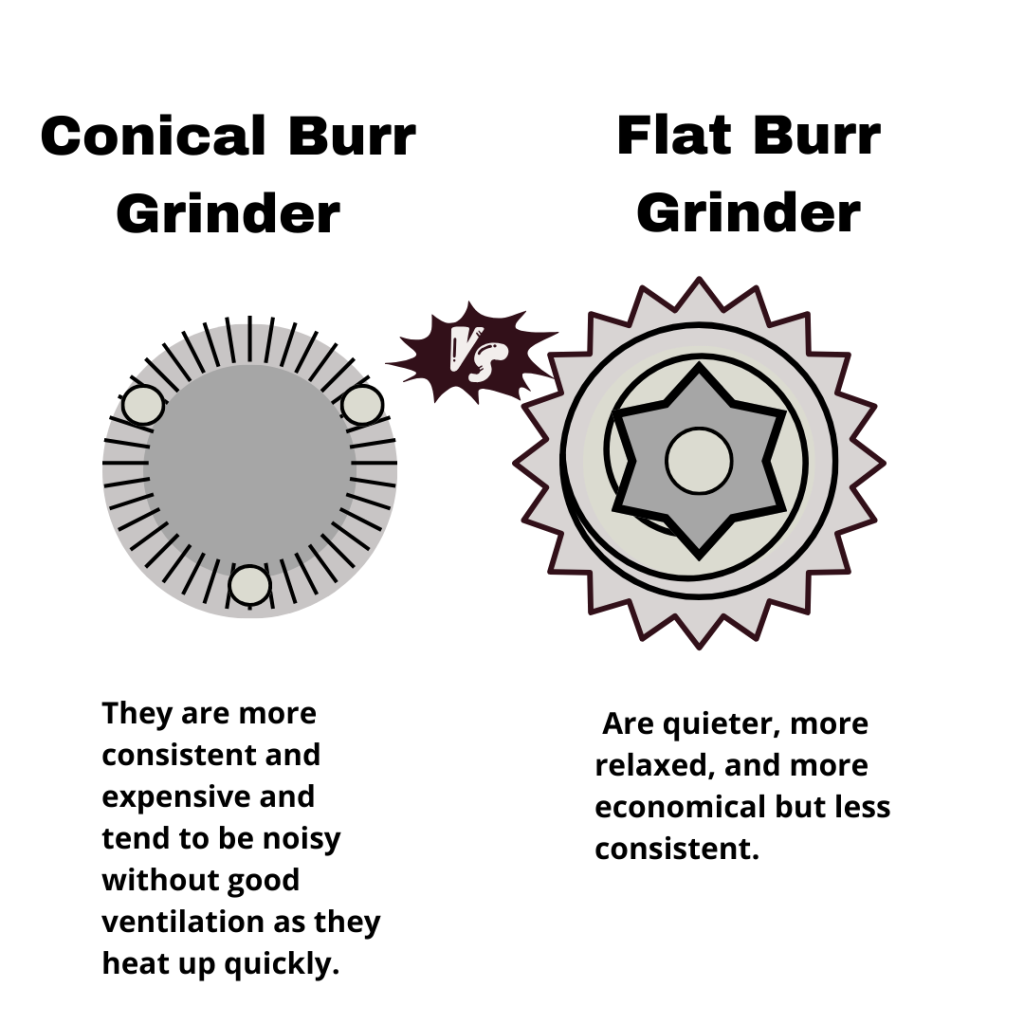Coffee aficionados often debate the advantages of different grinders, especially when it comes to which is a better flat or conical burr grinder? Grinder choice isn’t just a matter of aesthetics or brand loyalty: it plays a critical role in determining the quality of your beer. The grinder is undoubtedly one of the most critical components of any coffee setup as it directly influences the flavor profile of your drink. When ground beans are uneven, inconsistent extraction results: some coffee particles are over-extracted and others are under-extracted, culminating in a brew that is far from perfect. Therefore, understanding your grinder is the first step to achieving that flawless cup of coffee. To help you make an informed decision, we’ve delved into the nuances of both grinders and compiled comprehensive data. Dive in and find out which grinder is your perfect match.

When we use a burr grinder, the quality of the coffee improves significantly because they grind the beans with pressure when passing between two surfaces or burrs and do not grind coffee and not cut them.
What are Conical and Flat Burr Grinders?
Flat Burr Grinder
A flat burr grinder features two horizontal metal or ceramic rings with serrated edges facing each other. As the coffee beans pass between these rings, they are ground to a constant size due to the pressure applied by the rotating burrs. This mechanism ensures a remarkably uniform grind, resulting in uniform extraction during brewing.
Conical burr grinders
Conical burr grinders, on the other hand, work by using a cone-shaped burr that sits inside another cupped conical, burr shape. The coffee beans go down through the burrs at a slight angle, but like the flat burr grinder, they are ground between the serrated edges of the rings. This design also produces a uniform grind size, which is crucial for achieving a balanced flavor in your coffee.
Reasons for selecting a burr grinder
Switching to a burr grinder, whether flat or flat and conical burrs, is a big step forward for anyone looking to improve their coffee experience. First, unlike blade grinders that chop beans indiscriminately, both burr grinders provide an even grind. This means fewer fine particles or over-extracted fragments in your drink, ensuring a cleaner, more consistent taste in every cup. In addition, with a burr grinder, the risk of overheating and possible alteration of the natural flavors of the coffee is reduced.
Which is better, the flat or conical burr grinder? The answer depends on several factors, including your brewing method and personal preferences, which we’ll explore in the following sections.
6 Differences between a flat and conical burr grinder
While both are excellent options, subtle differences may influence your decision. Here’s a detailed breakdown:
| Feature | Flat Burr Grinder | Conical Burr Grinder |
|---|---|---|
| Consistency | More precision grind consistency, uniform routine. Preferred for espressos and various coffee types. | It may have more retention, requiring frequent adjustments, especially in professional settings. |
| Bimodal vs. Unimodal Distribution | Defends unimodal distribution for consistent particle size. | It can retain more heat, potentially affecting grind size and flavor—more power is required. |
| Temperature Stability | It shows a bimodal distribution, offering a balance in extraction between bitterness and sweetness. | Less heat retention, preserving the flavor profile of the coffee. Better for temperature stability. |
| Retention | Typically, there is less retention due to gravity assistance in vertical movement. | Quieter offers a more peaceful grinding experience. Less frequent adjustments are needed. |
| User Experience | Performance is influenced by construction, speed, ventilation, motor quality, and materials. | It is noisier and may require more adjustments due to retention factors. |
| Shape of the Cutter | Performance influenced by construction, speed, ventilation, motor quality, and materials. | Similar to flat burrs, with performance nuances based on construction and material qualities. |
1. Consistency
The very essence of a good grinder is its ability to produce consistent ground coffee. While both burr grinders outshine the blade variants in this area, the flat burrs win in precision grind consistency. Its construction requires parallelism, which produces a more uniform routine. This precision often makes them more expensive than their tapered counterparts, which require perfect centricity and alignment.
2. Bimodal versus unimodal distribution:
Upon close inspection, conical mills reveal a bimodal distribution: two different particle sizes. This mixture of smaller and larger particles is traditionally preferred for espresso preparation. Contrasting sizes balance extraction between bitterness and sweetness. On the contrary, flat mills defend an unimodal distribution. This consistency is favored for both espressos and other forms of coffee.
3. Temperature stability:
Heat can be the enemy of the coffee grinder. Flat grinder burrs, which require more power, can retain heat, especially on cheaper models. This heat retention can affect the grind size and, consequently, the flavor profile of the coffee. Temperature spikes can further challenge flat burrs in bustling environments like coffee shops. Although this requires baristas to keep an eye on adjustments, for the casual homebrewer, this difference is minimal.
4. Retention:
Grinders sometimes retain some coffee grounds, which is called “retention.” These residues can affect the consistency and flavor. Thanks to the assistance of gravity in the vertical movement, conical grinders tend to have less retention than flat burrs. However, the exact disparity depends on the specific make and model of the grinder.
5. User experience:
Flat burrs may be noisier. Therefore, conical ones may be your best option if you are looking for peace of mind. Additionally, due to the retention factor, flat burr grinders may need more frequent adjustments, especially in professional settings.
6. Shape of the cutter:
While the cutter’s shape is essential, it is not the only determinant of a grinder’s performance. Factors such as construction, speed, ventilation, motor quality, and materials play an essential role. For example, ceramic burs tend to stay sharp longer than steel burs but are also more susceptible to damage. However, the distinction in performance is subtle.
Which is better: a flat or conical burr grinder?

Burr coffee grinders are the best choice for people if they want to make delicious espresso shots. Credit image Pixabay
Opting for a burr grinder instead of a blade grinder is the first step to achieving a more consistent grind and, subsequently, a richer coffee flavor. However, the debate does not end there. The choice between conical or flat burrs and conical burr grinders adds another layer to this pursuit of excellence.
Flat burr grinders, in the flat burr coffee grinders in general, are known for their precision. They promise a very consistent grind but have a higher cost. Their design, which often requires more power, makes them noisier and potentially more susceptible to overheating. Additionally, they may retain a slight amount of coffee grounds, which could influence the taste of consecutive brews.
On the contrary, conical burr grinders are usually cheaper, operate at a lower temperature and grind faster. Their design often results in less retention of coffee grounds, ensuring fresher brews every time. Additionally, they tend to produce a bimodal particle distribution, which some coffee aficionados prefer for specific espresso brewing and methods.
Frequently Asked Questions about Which is Better Flat or Conical Burr Grinder?
1. What is the advantage of a flat burr grinder?
Flat burr grinders offer several advantages, not the least of which is precision. They provide a consistent grind, ensuring uniformity in the size of the coffee particles. This uniformity is especially beneficial for brewing methods that require uniform extraction, as it prevents bitter or sour flavors that can arise due to over- or under-extraction. Additionally, flat burr grinders typically produce a unimodal particle distribution, making them the preferred choice for those who want consistency in their brew. Additionally, the design and construction of end mills typically allow for more straightforward calibration and maintenance.
2. Why use a conical burr grinder?
Conical burr grinders have their advantages:
They typically operate at lower RPMs (revolutions per minute), which means they generate less heat and are less likely to cause heat-induced flavor changes in your coffee.
They usually have a more efficient and faster grinding process, thanks to the force of gravity that helps the movement of the grains. Conical burrs also tend to produce a bimodal particle distribution, which some prefer for specific brewing methods, especially espresso, as they can balance flavors.
These grinders typically hold less ground coffee, resulting in fresher brews later, and are generally quieter in operation.
3. Are flat burr grinders better for espresso?
Grinder choice for espresso often comes down to personal preference. Still, many professionals and enthusiasts lean toward flat burr grinders for this brewing method. The main reason is the unimodal particle distribution offered by flat burrs, ensuring that all coffee beans are the same size. This consistency is crucial for espresso, where uniform extraction is vital to avoid over-extraction (bitterness) or under-extraction (acidity). However, some baristas prefer flat burrs to produce the bimodal distribution of conical espresso grinders, believing it provides a more balanced extraction by combining the benefits of fine and coarse grinds. The debate continues, but flat burr grinders are undoubtedly popular for making espresso.
conclusion
The best grinder comes down to individual needs and preferences. If precision is paramount and you’re willing to invest a little more, a flat burr grinder might be the way to go. But if you’re looking for value, efficiency, and cooler operation, a conical burr grinder might be your perfect choice. Whether you’re a coffee shop owner or a home brewer, understanding these nuances of the right coffee grinder ensures that every cup of coffee you make is one step closer to perfection.
